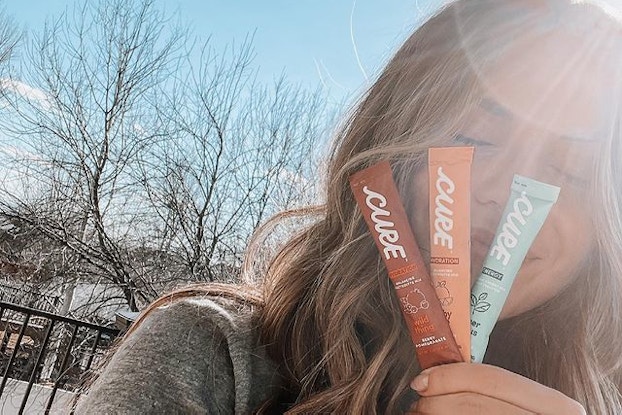
Why it matters:
- U.S. marketers will allocate nearly $1 billion more to influencer marketing this year than they did in 2020.
- Brands are tapping micro-influencers, trendsetters with 10,000 to 50,000 followers, to forge authentic, community-minded connections with consumers that can be trickier to do with mega-influencers.
- Scaling startups Pura Vida, Cure Hydration and Andie are generating sales lifts and customer acquisition gains from their micro-influencer strategies.
Many of the highest-paid influencers on platforms like Instagram and TikTok are also some of the most powerful voices when it comes to consumer culture and swaying retail purchases.
So, it comes as little surprise that U.S. marketers will allocate nearly $1 billion more to influencer marketing this year than they did in 2020, according to eMarketer.
However, as the nature of celebrity changes, so, too, has the relationship between a brand and its spokespeople, and a valuable subsector has now come to the fore: micro-influencers.
While each brand has its own benchmark for the follower count they consider worth the label “micro-influencer,” marketing agency Mediacy defines them as trendsetters with 10,000 to 50,000 followers, naming those with fewer than 10,000 “nano-influencers.”
Despite the smaller follower count, these micro- and nano-influencers often have a palpable impact on their audiences and the ability to leverage that authentic connection with followers into clicks and sales conversions for their brand partners, experts said.
The value that they bring is grassroots; it's very organic. It allows the word of mouth to happen.Griffin Thall, CEO and co-founder, Pura Vida
Leveraging authenticity as currency: ‘They’re going to be a bit more candid and down to earth’
Micro-influencers generally command lower fees than those with higher follower counts, making them a more cost-effective investment than mega-influencers while providing a way to expand and diversify the cast of voices representing the brand.
“Micro-influencers have incredible reach and buy-in from their communities,” says Kelsey Patsch, influencer and affiliate manager at direct-to-consumer swimwear brand Andie, whose influencer strategy is integral to its marketing from print campaigns to paid social ads. “Their followers look to these influencers to make recommendations specific to their experiences.”
“It’s like shopping small at a farmers market instead of going to the corporate behemoth across the street,” says Greg Bruce, a creative at Translation, a marketing agency which regularly incorporates influencers into its clients’ brand strategies. “Micro-influencers aren’t going to just throw the product, the price and the benefit in your face,” he said. “They’re going to be a bit more candid and down-to-earth about the brands they partner with.”
[How Influencers Are Forging Trust Between Consumers and Brands Amid COVID-19]
Targeting niche interest groups via micro-influencers
Working with micro-influencers can be the key to reaching new customers, particularly as some of the power of mega-influencers wanes among consumers. According to global research from Savanta, 56% of social media users would rather follow everyday people than celebrities as they believe their content is more authentic.
“In the beginning, Instagram influencers were very influential for generating sales and new followers to our accounts,” says Griffin Thall, CEO and co-founder of DTC bracelet brand Pura Vida. “But over the past two years, it's become less effective, because the market is so saturated.”
While bigger influencers may have greater audience reach, their customer engagement level isn't usually as high as micro-influencers, since their content may cover a wide variety of topics, Lauren Picasso, founder and CEO of electrolyte beverage brand Cure Hydration, told CO—.
By contrast, “Micro-influencers often have more loyal and engaged audiences than macro-influencers because they're usually focused on a niche interest,” she said.

A cost-effective customer acquisition strategy
For many new brands, building a community of brand ambassadors is one of the most cost-effective customer acquisition channels.
For swimwear brand Andie, micro-influencers offer an opportunity to work with people who specialize in the type of voice that aligns with the brand’s message of body positivity or can help the brand flex into new communities and demographics.
Both Pura Vida and Cure Hydration incorporate ambassador programs into their social media marketing strategies. These brand ambassadors are, by definition, micro-influencers.
Thus far, Pura Vida has had 125,000 brand ambassadors sign up for its program, which has no minimum follower count to participate and rewards members for every purchase and share.
“The value that they bring is grassroots; it's very organic,” says Thall. “It allows the word of mouth to happen.”
Cure Hydration’s program is more selective, recruiting around 125 members from a range of target demographics and niche communities, such as fitness or nutrition. As the brand collects sales and social data, Picasso says, it has discovered new consumer niches – including those using the product during pregnancy or breastfeeding or for headaches – and adjusted its ambassador recruiting process accordingly.
Measuring the return on investment in audience reach, customer engagement
With a low cost and potential for big payoff in terms of both community-building and sales conversion, micro-influencer marketing can deliver a meaningful return on investment, particularly for brands new to the market, founders told CO—.
“Cure Hydration only works with influencers on a commission basis versus a flat fee,” Picasso said, comparing the program to work with macro-influencers “As a result, we see six times the return on investment with micro-influencer partnerships.”
Andie has also seen success from shifting to incorporate more micro-influencer voices in its brand conversation. “We've been able to more than double our Instagram following in a year, and we've scaled from an influencer program of one, to five major paid influencers a month, to up to 300 per month in peak seasons,” Patsch says.
According to Andie, micro-influencers extend the brand’s potential monthly reach from around 100,000 audience members to over 700,000, with micro- and nano-influencers generating a customer engagement rate averaging 7%, compared to 2% generated by macro-influencers.
“With a more engaged audience and a more affordable approach,” Patsch adds, “the micro-nano strategy almost can't be beat.”
CO— aims to bring you inspiration from leading respected experts. However, before making any business decision, you should consult a professional who can advise you based on your individual situation.
Follow us on Instagram for more expert tips & business owners’ stories.
CO—is committed to helping you start, run and grow your small business. Learn more about the benefits of small business membership in the U.S. Chamber of Commerce, here.









